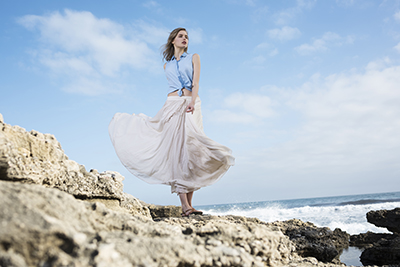Choosing Your Second Lens
What’s the next lens you should get for your digital SLR?
The answer is going to be different for every person and depends upon the answers to some simple questions.
Without question, the greatest advantages of digital SLRs (DSLRs) are their ability to change lenses instantly, and to see exactly what your picture will look like in a bright, eye-level, optical viewfinder. These signature features provide unparalleled optical and framing flexibility, allowing you to pick the precise type of lens that best suits your subject and shooting style—from ultra-wide angles to super-telephotos and everything in between. But to get the most out of your DSLR, you must choose the “right” lenses and making that second lens choice is probably the most critical of those decisions.
What do you already own?
Seems simple enough, right? The first question to answer is what are you using with your DSLR now?
By far the most popular first lens bought with a DSLR is a short zoom lens (sometimes called a “standard” zoom) such as the 18-55mm f/3.5-5.6 zoom lenses offered by Canon, Nikon, Sony, Pentax and others as standard with their DSLR starter outfits and kits. The 18-55mm, which is equivalent to a 28-85mm lens on a 35mm film camera, provides wide-angle to medium telephoto coverage and a 3:1 tele-to-wide zoom ratio. Compact, lightweight, and inexpensive, the 18-55mm is a great starter lens for general photography that lets you enter the wonderful world of DSLR photography without breaking the bank.
Thinking outside the ‘box’
But these “starter outfit” lenses aren’t for every first-time DSLR purchaser. Many first-time DSLR purchasers now pick a longer-range wide-to-telephoto mega-zoom as their first lens. The classic Tamron 18-200mm XR Di II f/3.5-6.3 (28-300mm equivalent on consumer DSLRs) is a popular choice, in lieu of the usual short zoom that “comes with the kit” because it’s compact, lightweight, and affordable. An increasing number experienced DSLR shooters are going whole hog and opting for the Tamron 16-300mm Di II VC PZD (with amazing 18.8x zoom ratio), the ultimate mega-zoom (18.8X, 16-465mm equivalent) with built-in second generation Vibration Compensation (VC) and advanced piezoelectric (PZD) autofocus motor and moisture resistant seals and an incredible 1:2.9 close focus, as a “universal lens” when acquiring a first or second DSLR body. The recently updated Tamron 28-300mm Di VC PZD is the choice for full frame sensor users. Over 10x zoom with all the above features including moisture resistant seals. On a budget? Tamron also offers 18-200mm Di-II and 18-270mm Di-II lenses with many of the above features.
No, even a 10X or 18X zoom can’t do absolutely everything, but these compact, lightweight, super-flexible lenses are fantastic choices for hiking a nature trail, shooting memorable travel, vacation, and family pictures, taking dynamic sports shots - or breathtaking close-ups in the near-macro range—in short, any time you want a compact, one-lens, do-everything outfit to cover as many picture-taking opportunities as possible. Lenses in the 16-300mm class are also a great choice for folks who want to get all the other advantages of using a DSLR without having to change lenses!
Another fascinating first lens for photographers who want to shoot natural looking non-flash pictures in low light is a fast, short zoom like the Tamron SP 24-70 f/2.8 Di VC USD G2. This lens, roughly equal to a 36-105mm view on an APS-C size sensor, offers the superior light-gathering ability of a wide f/2.8 aperture at all focal lengths—great for street photography and indoor “available light” shooting. Shooting at wide apertures like f/2.8 also lets you capture stunning pictorial effects by using their limited depth of field to throw the background pleasantly out of focus while making the main subject “pop.” None of these alternative first lenses is as inexpensive as a normal zoom, but in the long run they may help you build an efficient DSLR lens arsenal more efficiently and at the lowest possible cost.
The wide, wide zoom: Great for small spaces and wide vistas
Do you take lots of pictures indoors—interior views, kids having fun in the family room, and groups of friends and relatives gathered around the holiday table? If so, an ultra-wide-to-wide-angle zoom like the Tamron SP 15-30mm f2.8 VC USD— one of the widest, longest lens in its class that provides an impressive 35mm-equivalent focal-length range of 30-45mm on an APS-C sensor — is the perfect second lens for you. This lens makes it easy to get everyone in your extended family into the picture, shoot in tight spaces, and capture all the action from an intimate perspective. It's also a superb choice for shooting expansive landscape pictures and scenic vistas, and for giving a more spacious look to everything from car interiors to small rooms. That’s why an ultra-wide zoom is considered the essential lens for taking real estate pictures of your house for posting on the Internet, and a great choice for travelers who want to bring back memorable photos of everything from spectacular night skies to historical landmarks.

The super telephoto: It’s for the birds…and wildlife and sports
If you like to take pictures of birds and other small, skittish woodland critters, or you’re into shooting big league baseball from the bleachers or NFL or college football from the 50-yard line, there’s nothing quite like a really-long telephoto zoom lens such as the Tamron SP 150-600mm G2 VC USD. On a consumer (APS-C sensor) DSLR, a 150-600mm is the equivalent of a whopping 225-900mm lens, a range that’ll let you capture intimate shots of birds in a nest or close-ups of that great catch in the outfield, and that’s why it makes a great second lens for these applications. This big gun is most effective on a tripod or monopod, but it’s also easy to handhold, and its aperture is fast enough to let you shoot at high shutter speeds to stop action and minimize the effects of camera shake. This is especially true with the latest crop of DSLRs that deliver superb image quality at ISO 1600, 3200, and even 6400. With next generation Vibration Compensation (VC) stabilization capable of providing conservatively 4.5 stops of motion reduction, your handheld shooting range with the 150-600mm is amazing.

More telephoto choices: The short of long
If you don’t need the spectacular reach of a moderately hefty 150-600mm and you want a smaller, lighter lens that’s easier to handhold, you should consider a shorter telephoto zoom like the award winning, best in class Tamron SP 70-300mm Di VC USD as your second lens. It’s the 35mm equivalent of a 108-465mm lens on consumer (APS-C sensor) DSLRs and it’s also a full stop faster than a 150-600mm, which means you can shoot at higher shutter speeds in low light. And it gets down to 1:4 close-up ratio at the 300mm setting, so you can get dramatic close-ups of everything from nature subjects like insects to small, detailed collectibles. The 70-300mm VC also provides reach for sports and wildlife. It’s relatively light in weight (27 ounces), and it covers both APS-C and full-frame formats making it popular with everyone from family sports photographers to pros. The 70-300mm’s ability to shoot close-ups from a greater distance (that is, its greater working distance) is also a real plus in all kinds of close-up photography, including nature shooting.

The ultra-compact Tamron 16-300mm Di-II VC PZD is another spectacular choice for the long-range shooter, delivering a maximum equivalent focal length of 450mm along with tri-axial Vibration Compensation on Nikon and Canon DSLRs (it’s also available without VC for Sony DSLRs that have in-body image stabilization). Another big plus: It gets down to 15.3 inches in macro-close focus mode, and, considering its breathtaking specs it’s amazingly light at just 19 ounces.
Telephoto macros: Super for close-ups and portraits
If you specialize in taking extreme close-ups or shooting portraits, you should seriously consider choosing a macro telephoto as your second lens. When it comes to taking pro quality close-ups of flowers, coins, or nature subjects, nothing beats a single-focal-length (non-zoom) macro lens such as the recently updated acclaimed medium-tele Tamron SP 90mm f/2.8 Di VC USD Macro, now with VC stabilization, moisture resistant seals, e-Band nano-coatings and fluorine coated front element. Plus, the long tele-macro companion, the Tamron SP 180mm f/3.5 Di Macro, or the remarkable super-fast aperture Tamron SP 60mm f/2.0 DI II LD Macro. All three of these extraordinary lenses get down to 1:1 (life-size on the sensor) for extreme close-ups, and each one provides the superb imaging performance that only a single-focal-length lens specifically calculated for macro photography can deliver. They also have wide apertures (f/2.8, f/3.5, and f/2.0 respectively) that let you focus and view with greater precision, a significant plus when shooting in the extreme close-up range and in low-light situations.

Macros for portraits? Yes, here’s why!
Having a long-focal-length 60mm (93mm equivalent on a APS-C DSLR), 90mm (135mm equivalent) or 180mm (270mm equivalent) macro lens is like having two lenses in one because both also make superb portrait lenses, and their wide maximum apertures allow you to use shallow depth of field (also called selective focus) to make your subjects stand out against the soft background. This time-honored technique has been used by many of the great portrait photographers past and present. Employing it with a 60mm, 90mm or 180mm lens is especially effective because it allows you to shoot portraits from a great enough distance to get a pleasing perspective that flatters your subjects and de-emphasizes defects such as prominent noses and ears. Many pro photographers know that a lens like the Tamron 90mm f/2.8 Macro is considered a “portrait tele” because of its focal length, but a significant number of today’s top portrait photographers are now using longer lenses like the Tamron 180mm f/3.5 Macro to achieve the even more dramatic portraits like those seen in leading magazines and portrait studios. The new Tamron 60mm f/2.0 Di II LD Macro gives consumer (APS-C-format) DSLR shooters the same dynamic portrait possibilities as top pros who shoot with high-end full-frame-DSLRs because of its incredible f/2.0 aperture (the fastest of any lens in its class), and the amazingly-shallow depth of field it provides when shooting at its widest aperture.

Ready for Prime time?
If you are looking for a way to see in new creative directions, consider adding a ‘prime’ lens to your camera bag. These fixed focal length lenses with superior optical performance and VC image stabilization can take your photography to new artistic levels – helping you visualize images before you press the shutter release. A great example is the Tamron SP 35mm f/1.8mm Di VC USD. The 35mm lens is a “classic” focal length for environmental and “street” photographers. It provides a wider angle of view than a traditional standard lens and flawlessly shallow depth of field at f1.8 allowing the photographer to capture incredibly sharp detail while isolating and emphasizing the subject. Stopping down allows you to control the depth of field to suit your needs. The Tamron SP 45mm f/1.8 Di VC USD is a focal length that closely mimics the magnification of the human eye and yet with its close-focusing capabilities captures delicate details that may otherwise go unnoticed. And if people are your passion, the Tamron SP 85mm f/1.8 Di VC USD is the classic portrait lens – allowing you to capture the personality within the portrait in a most flattering way. Whether you’re a seasoned veteran or an aspiring portrait photographer, you need to consider having a Tamron 85mm in your camera bag. Like the 35mm and 45mm lenses, the 85mm can also make great landscape photographs. The Tamron prime lenses are all ‘Di” models, meaning they will work on both full frame and APS-C sensor bodies. The effective fields of view on APS sensors are approximately as follows: 35mm=53mm, 45mm=68mm and 85mm=128mm. Slight variations may occur due to the variations in camera sensor sizes.

A happy medium: A fast semi-wide to moderate telephoto
Are you the type of photographer who shoots in the medium range and wants a great compact, lightweight general-purpose lens with a wide enough aperture for very bright viewing and effective low light shooting? A fast, wide-to-moderate telephoto lens like the Tamron SP 24-70 f2.8 Di VC USD may be just the ticket as your second lens. Its coverage on a consumer DSLR is equal to a 36 to 105mm lens on the full-frame format, a very useful range for reportage, street shooting, and general events coverage. That’s why the 24-70mm is popular with pros and “weekend warriors” who generate or supplement their income shooting weddings and other events where the action is fast and the lighting isn’t always predictable. Its zoom ratio may not sound too impressive but performance is—which is why you’ll find this “go-to” focal length in many pros’ bags. As a Tamron “Di” lens, it covers full-frame cameras and “APS-C” sensor cameras, making it suitable for pros and advanced amateurs.

Conclusion
There are so many subjective factors in choosing lenses for your DSLR and there are as many answers to the question “What second lens should I buy?” as there are photographic styles and working methods. But the most important thing to remember when buying your second lens is to pick one that compliments your first lens to extend your photographic range. If you’re like most photographers, your first and second lenses are the foundation of your photography experience. Soon you’ll think about acquiring a third and fourth lens. Hopefully we’ve provided enough good solid info here to let you do that, too.
Good shooting!